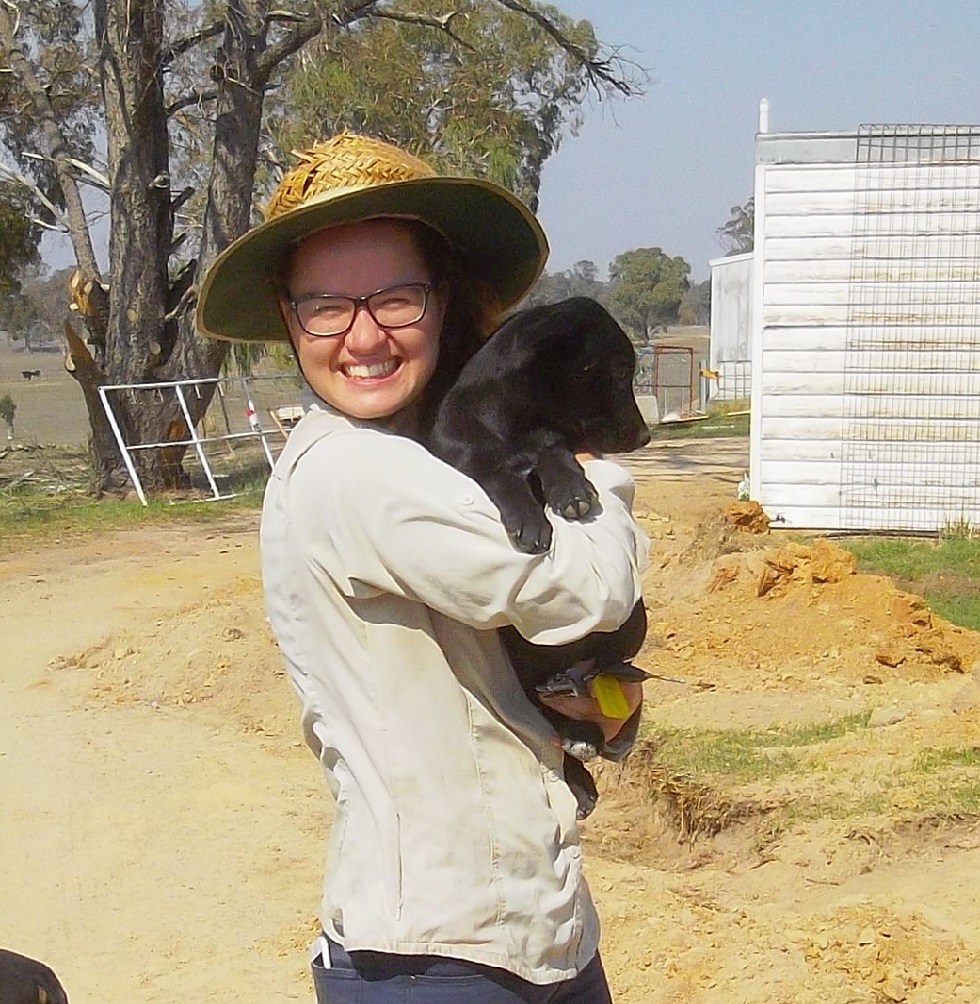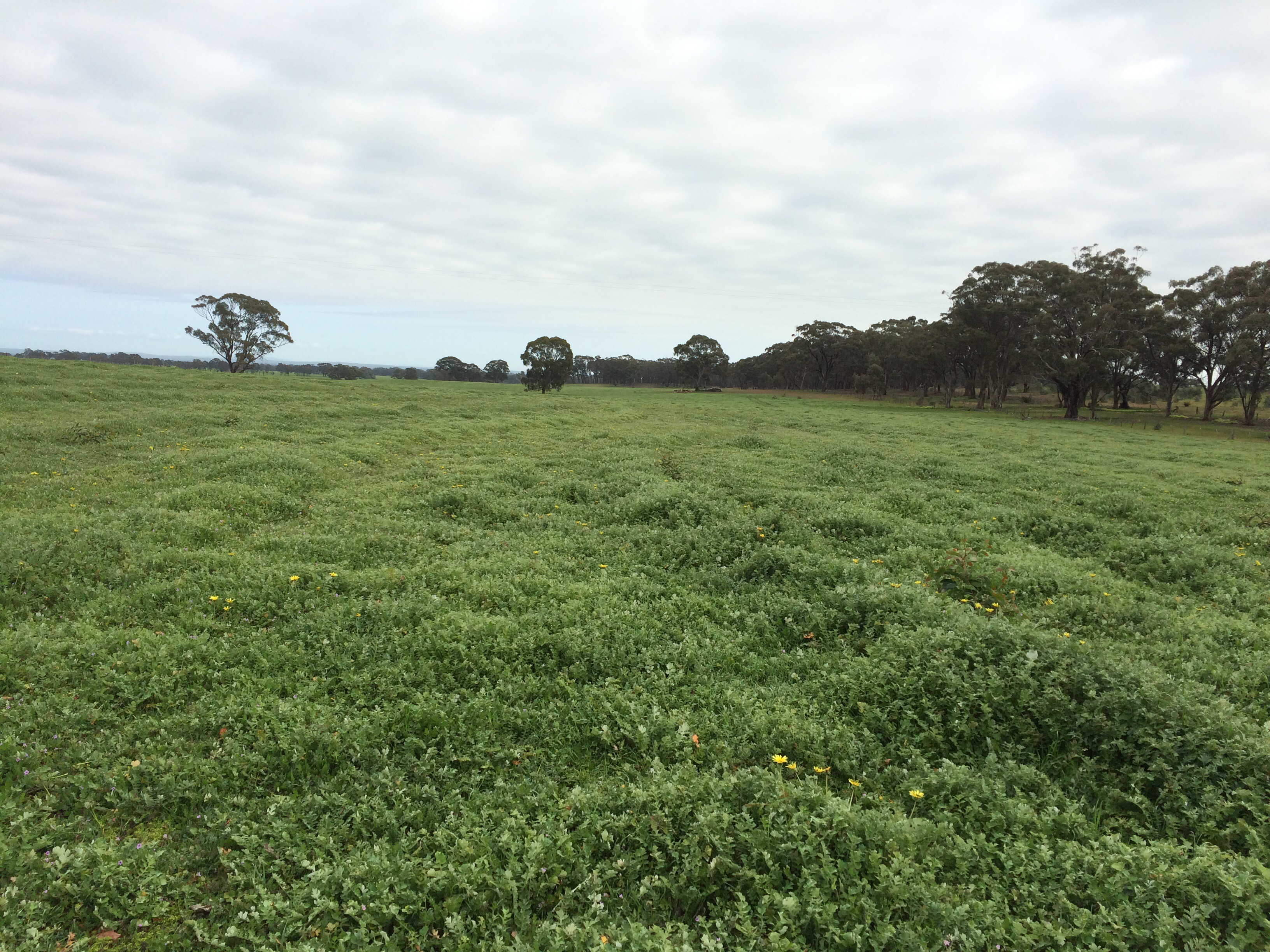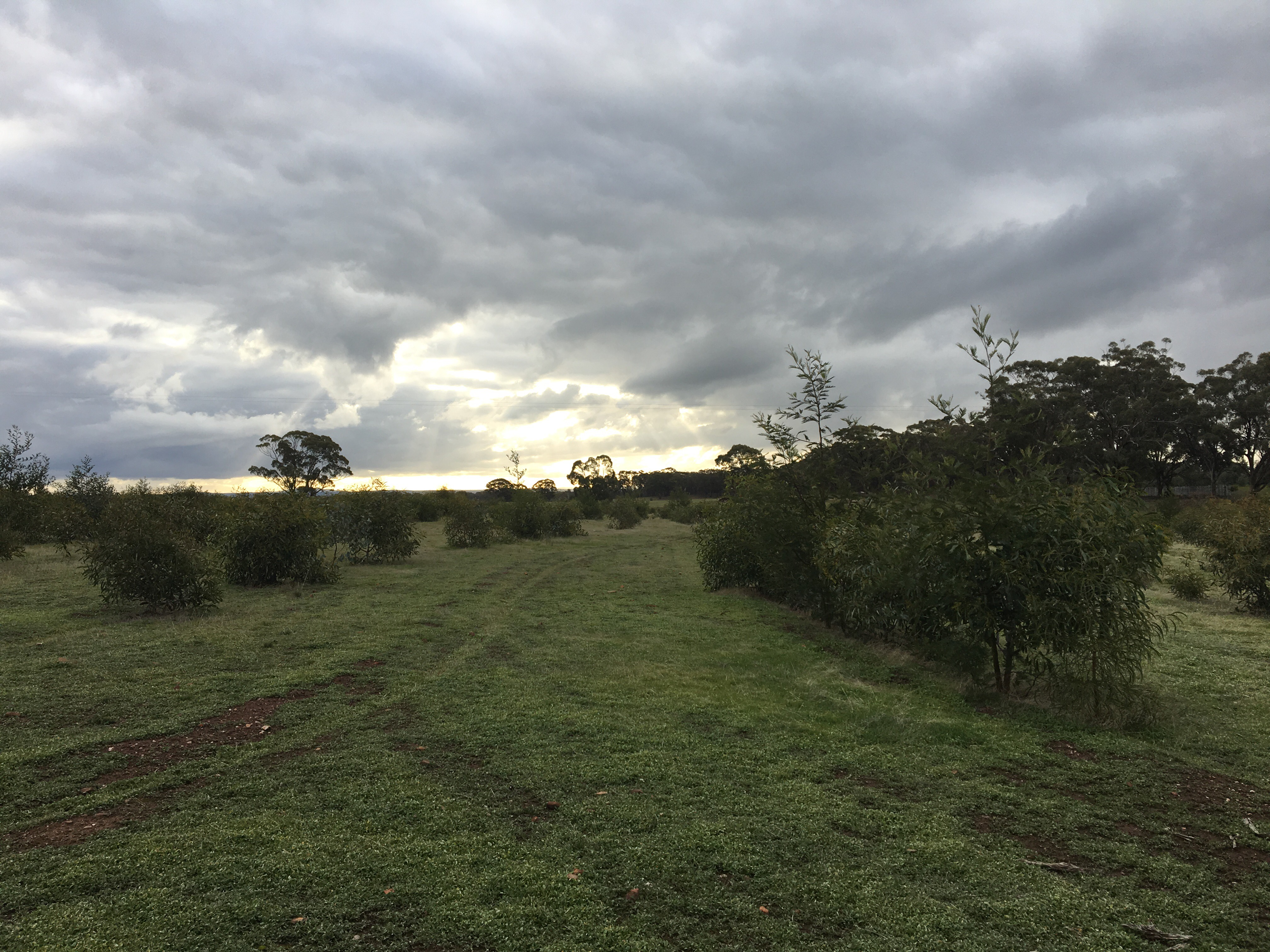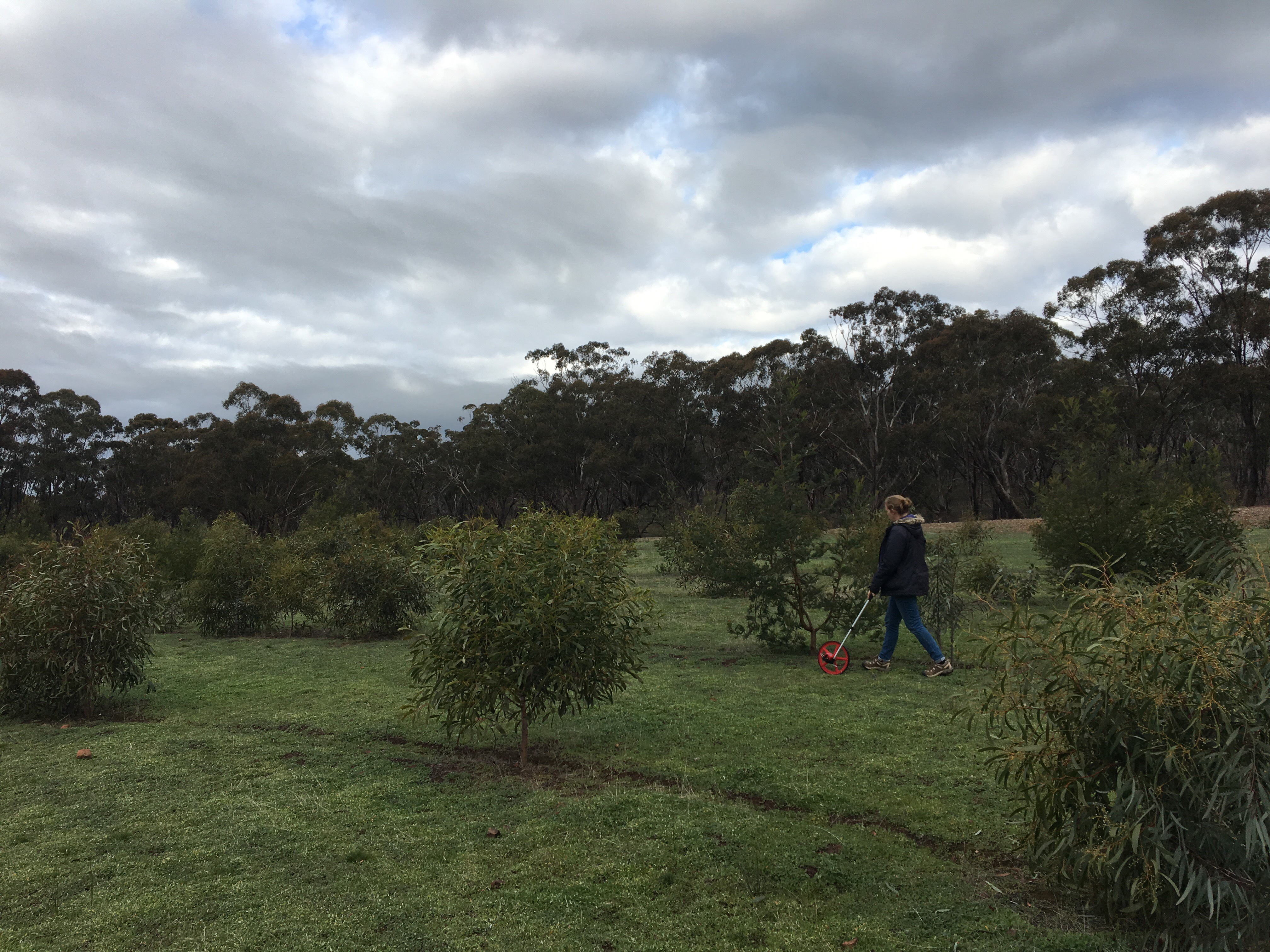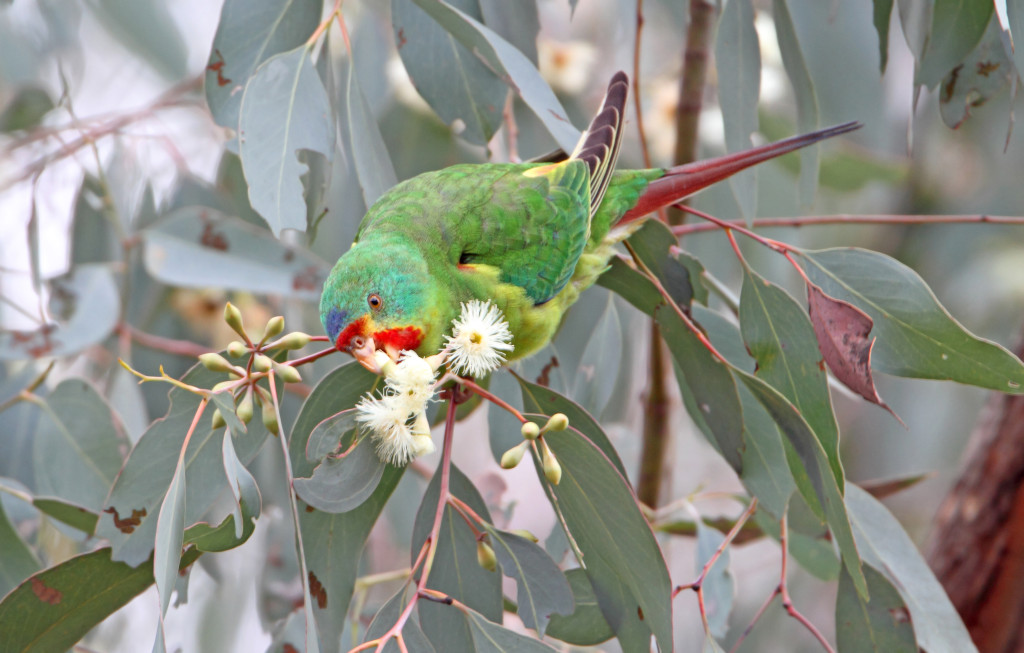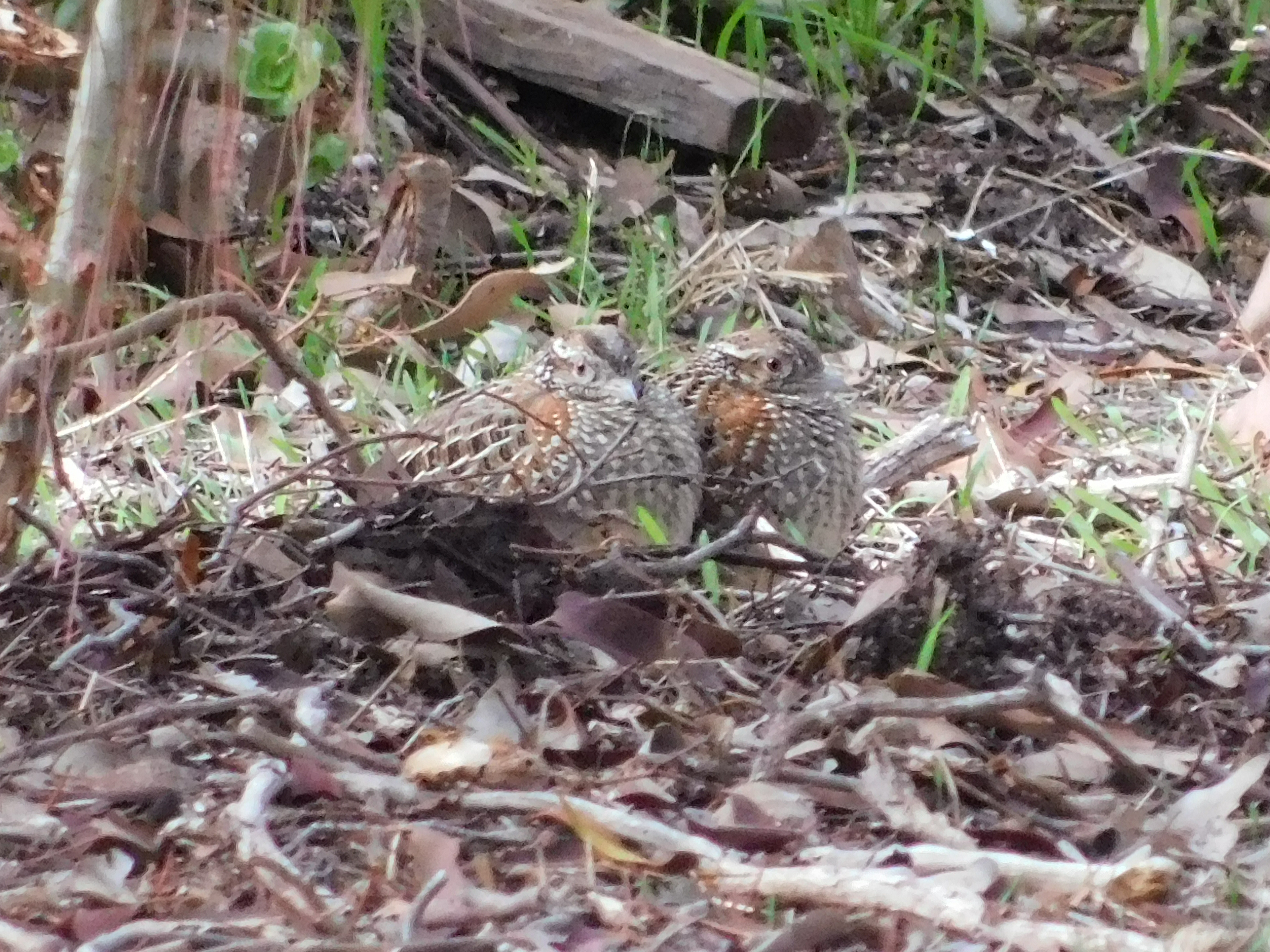April bird walks – Birdlife Castlemaine District
Posted on 2 April, 2019 by Asha
Birdlife Castlemaine District have two great walks coming up in April 2019:
Saturday 6 April – Coliban Main Channel, Tyquins Road, Taradale
This walk follows the Coliban water channel. With a reliable water supply, plenty of edge habitat and open forest, this track often produces good lists of birds. It is a flat walk mostly, as it follows the contour alongside the water channel. Access is via a stile over the fence. The walk will be led by Damian Kelly, local bird expert, photographer and author of Castlemaine Bird Walks: A guide to walks and birds in the Castlemaine District.
Location and directions: Coliban Main Channel, Tyquins Road. From Taradale take the Old Calder Highway towards Malmsbury. About 1.9km from Taradale turn right into Conlans Road and follow this about 700m to a T-intersection. Turn left here, which is the continuation of Conlans Road, for about 1.2km until you reach Tyquins Road. Turn left into Tyquins Road and continue for about 1.6km until you reach Channel Track on your right. The old Tyquins Cottage is situated here. You can park here or go up the rough track another 150m and park near the gate.
Time: Meet at Tyquins Cottage at 9:00am, or to carpool from Castlemaine meet at 8:30am outside Castlemaine Community House (formerly Continuing Ed), Templeton Street.
Sunday 14 April – Bald Hill Reserve, Kyneton (rescheduled from March)
This is a very special bird walk at Bald Hill Reserve, Kyneton, jointly led by Friends of Bald Hill Reserve and BirdLife Castlemaine District. The Reserve is a very beautiful and special place, with 3 distinct habitat types. The Friends group has achieved so much in helping the public appreciate its significance and, with Carolyn Robb from the Friends group bringing her incredible local knowledge, this is a walk not to be missed. To discover more about Bald Hill Reserve click here.
Location and directions: Bald Hill Reserve, Mount St Mary’s Lane, Kyneton. Approach Mount St Mary’s Lane from the south, off Pipers Creek Street – the Reserve is well signposted on your left.
Time: Meet at Bald Hill Reserve at 9:00am, or to carpool from Castlemaine meet at 8:15am outside Castlemaine Community House (formerly Continuing Ed), Templeton Street.
Important information about walks: Bring water, snacks, binoculars, hat, sunscreen, sturdy shoes, long pants during snake season, and other weather-appropriate gear.
Walks will be cancelled if the temperature is forecast to be 35 degrees or more during the walk period, severe weather warnings are forecast, and/or if the day has been declared a Total Fire Ban.
Questions? If you have questions about the bird walks program, you can email castlemaine@birdlife.org.au, or call Judy Hopley (0425 768 559) or Asha Bannon (0418 428 721).
Bird walk at Bald Hill – 2 March 2019
Posted on 20 February, 2019 by Frances
 BirdLife Castlemaine District Branch, together with Friends of Bald Hill Reserve, are running a special bird walk at Bald Hill near Kyneton VIC. Bald Hill Reserve is a unique and beautiful place, with three distinct habitat types. The Friends group have achieved much through encouraging the public to appreciate its natural significance and on-ground works.
BirdLife Castlemaine District Branch, together with Friends of Bald Hill Reserve, are running a special bird walk at Bald Hill near Kyneton VIC. Bald Hill Reserve is a unique and beautiful place, with three distinct habitat types. The Friends group have achieved much through encouraging the public to appreciate its natural significance and on-ground works.
Carolyn from the Friends group will share her incredible local knowledge, making this an event not to be missed.
Bald Hill bird walk
When: 2 March 2019 from 8.30 am
Meet: 8.30 am at Bald Hill Reserve, or if car pooling from Castlemaine meet at 7.45 am at Castlemaine Community House (former Continuing Education building), 30 Templeton St, Castlemaine VIC
Where: Bald Hill Reserve, Mt St Marys Lane, Kyneton VIC (approach Mt St Marys Lane from the south, off Pipers Creek St, and Bald Hill Reserve is well sign posted on your left)
Bring: Please wear long trousers and sturdy shoes as snakes may be out and about. Bring sun protection including a hat, and plenty of water.
Walk leaders will be Jane Rusden and Carolyn Robb.
Find out more about Bald Hill Reserve here: http://www.friendsofbaldhillreserve.com.au/
Bountiful bird baths
Posted on 23 January, 2019 by Tanya Loos
It is true, we have previously written about the wonders of bird baths for birds and other fauna. But with another heat wave hitting this week, we are sharing a new gallery of pics of animals using local bird baths during our recent hot weather. On a 40 degree day, fresh cool water can be literally a life saver!
However, avian visitors are more common. How many bird species can you identify visiting this bird bath? Hover your mouse over the right hand side of the gallery to click on the arrow and move through these photos taken by Frances Howe…
Plains for the wanderer talk with Castlemaine Field Naturalists Club – 9 November 2018
Posted on 31 October, 2018 by Tanya Loos
Connecting Country is proud to work with Trust for Nature and delighted to promote the latest presentation with the Castlemaine Field Nats.
Deanna Marshall will present on ‘Plains for the wanderer‘ about a small grassland bird who is doing it tough – the Plains Wanderer. Deanna Marshall is Trust for Nature’s North West Area Manager, and has been working hard to help Plains Wanderer habitat in this region.
Deanna supplied the following about these cryptic and special birds:
‘Plains-wanderers are nationally critically endangered. They share a physical resemblance to quail, but in evolutionary terms, they are one of a kind – there’s no bird like it in the world. In Victoria, 95% of native grasslands that Plains-wanderers formerly occupied have been lost to cultivation and urban development. The protection and maintenance of the habitat of the Plains-wanderer is vital for the conservation of the species, but will this be enough?’
The event commences at 7.30 pm on Friday 9 November 2018 in the Fellowship Room, located in the building behind the Uniting Church on Lyttleton St, Castlemaine VIC (next door to Castlemaine Art Museum). Following Deanna’s talk and questions, tea and snacks will be available.
Woodland birds of central Victoria with Chris Tzaros – 13 October 2018
Posted on 9 October, 2018 by Asha
Axe Creek Landcare invites you to:
Working with Nature — conserving woodland birds with special guest, Chris Tzaros (Birds, bush and beyond)
- Join Axe Creek Landcare for a visual extravaganza of award winning bird photography from wildlife ecologist Chris Tzaros.
- Learn about the habitat requirements of our woodland birds, why some are endangered and what conservation actions you can do to reverse local declines.
- Meet neighbours and people and network to develop ideas for future on-ground activities.
- Join optional local field trip for those interested in learning more in the field.
- Light lunch provided.

When: Saturday 13 October 2018 from 10:00 am – 3:00 pm AEDT
Where: Emu Creek Hall, Cnr Emu Creek and Hargreaves Rd, Emu Creek (via Strathfieldsaye), VIC 3551
Bookings: click here
For more information please contact Adrian Martins on 0427 099 376.
Threatened fauna forum and our AGM – 10 November 2018
Posted on 20 September, 2018 by Tanya Loos
A date for your diary! Join Connecting Country for an afternoon/evening of science, food and fun.
Hear from two leading scientists and share a yummy vegetarian meal, incorporating our (famously short) AGM.
All welcome!
Threatened fauna forum and AGM
Saturday 10 November 2018 from 4.00 to 7.00 pm
Campbells Creek Community Centre (45 Elizabeth St, Campbells Creek VIC)
Our presenters are both wonderful supporters of Connecting Country. Andrew helped design both of our long term monitoring programs (woodland birds and nest boxes). Jess has incorporated the Connecting Country nest box data into her PhD on Brush-tailed Phascogales. Jess also assisted enormously in our 2018 nest box check.
 Professor Andrew Bennett (La Trobe University & Arthur Rylah Institute): Connecting Country’s woodland bird data – trends and questions
Professor Andrew Bennett (La Trobe University & Arthur Rylah Institute): Connecting Country’s woodland bird data – trends and questions
PhD candidate Jess Lawton (La Trobe University): Results of Connecting Country’s Brush-tailed Phascogale monitoring
RSVP is essential if you wish to join us for dinner.
For more information and bookings email tanya@connectingcountry.org.au or phone 5472 1594.
To view our flyer for the event: click here
This threatened species forum is generously supported by the Helen Macpherson Smith Trust via our Habitat Health Check project.
Baringhup Birds on Farms workshop – a great partnership event
Posted on 13 September, 2018 by Tanya Loos
On 9 September 2018 about forty people gathered on a beautiful property in Baringhup to learn about Birds on Farms. The day was a joint workshop by Connecting Country and Baringhup Landcare, and the participants ranged from Connecting Country regular workshop enthusiasts, bird survey volunteers, farmers from in and around the Baringhup area and Landcare members.
Two bird surveys were conducted down on the bird survey area. Curiously each survey recorded 13 birds, though each time the species composition was different! The surveys may be seen here and here. A few new species were recorded on the day – including the Grey Fantail.
Many thanks to Roy and Caroline Lovel for being such wonderful hosts, and all the many helpers on the day, especially Jackie Brown who helped Roy wash up all the bowls and cups!
Attendee Liz Burns wrote this wonderful summary of the day. Thanks Liz!
Birds On Farms workshop
As a long-term attender of Connecting Country’s field days, it was a pleasure to take up Tanya’s request for someone to write up today’s events. In fact, I could write a book with all the detailed notes that I’ve taken over the years.
As usual, this one hit the mark and maintained the usual high standard.
As a full-time biological farmer who relies upon our native birds for pest control and even some pollination services, and a keen lifelong observer of all the complex relationships in nature, this is a subject dear to my heart. It was even more heartening to meet other like-minded farmers with the added bonus of passionate protectors of very old trees.
To read Liz’s detailed notes of the speakers’ presentations click Birds-On-Farms-Field-Day-write-up
After lunch we did separate farm and birds walks: Roy led a group up to the top of the property, and Tanya and Chris conducted a bird survey on a lower restoration area.
I would like to see the Connecting Country model rolled out across the State, as the best value for money blending of agriculture, environment and Indigenous history, especially as 70% of the State is in private hands and the State does not manage Crown Land very well (in my opinion). If farmers could be helped with managing their land, incorporating environmental and cultural values, we could maximise biodiversity and future food production with a three-way partnership with farmers, environmentalists and Traditional owners.
As usual, the catering, the company and weather was of the highest standard.
Grateful thanks must go to Connecting Country and all involved, but in particular Tanya Loos for yet another fascinating and informative day.
Liz Burns, Trewella Farm, Musk
Please scroll through the following gallery of photos from the day.
Biodiversity Response Planning: a new Connecting Country project
Posted on 13 September, 2018 by Tanya Loos
Biodiversity Response Planning projects announced
Over the six months, a diverse array of government, Traditional Owner and community organisations from across Victoria came together to participate in an intense Biodiversity Response Planning process. Connecting Country was one of these organisations!
After a lot of hard work, 89 new projects were just announced by the Hon. Lily D’Ambrosio MP, including 85 projects for on-ground biodiversity action worth $33.67 million. These projects are part of the government’s investment to implement Protecting Victoria’s Environment – Biodiversity 2037 and will be delivered by various stakeholders over the next three years.
Connecting Country is excited to announce that our proposed project was selected for funding.
For the full list of successful projects visit: https://www.environment.vic.gov.au/biodiversity/biodiversity-response-planning
Our project: Remnant rescue – restoring woodland bird habitat in central Victoria
We know that much of central Victoria’s native woodland has been heavily disturbed by a long history of mining, clearing, woodcutting, grazing, and changes in fire and water regimes. The Box-Ironbark landscape contains provides habitat for many threatened species including the threatened Temperate Woodland Bird Community. Scientific studies demonstrate an alarming acceleration in the decline of most species within this community over recent years. Habitat loss is the single greatest threat to woodland birds, and exacerbates other threats, such as predation by cats and foxes, and prolonged drought. Many of the remaining woodlands lack complexity and are missing the key understorey species that provide food, nesting sites and protection from predators for woodland birds and other animals.
Within the Mount Alexander region, large areas of remnant woodlands and priority habitat exist on private land. Through our work, Connecting Country has identified numerous private landholders with the interest, enthusiasm and capacity to protect and restore woodland habitat on their land, but require guidance and practical assistance.
This project restores habitat for the Temperate Woodland Bird Community by focusing on weeds and rabbit control to promote natural regeneration of native species. We’ll supplement this by strategic revegetation with key missing understorey plants to increase species diversity and community complexity. The project targets 60 ha of priority areas of potential habitat on private land, engaging landholders to develop appropriate management actions tailored for their properties. We’ll also implement weed and rabbit control on 40 ha of complementary areas of public land.
Connecting Country is proud to oversee the project in collaboration with our project partners: local landholders, Dja Dja Wurrung, Trust for Nature, Parks Victoria and Department of Environment, Land, Water and Planning.
Castlemaine Bird Walks – a recommended resource
Posted on 29 August, 2018 by Tanya Loos
In April 2018, local birder and photographer Damian Kelly published the wonderful book Castlemaine Bird Walks: A guide to walks and birds in the Castlemaine district. The book has been warmly received by the local community, selling over 500 copies, and is now in its third reprint.
As our supporters know, we’re very much into birds here at Connecting Country. Hence we thought it timely to review this useful resource for our bird survey volunteers, or anyone interested in local birds.
 Castlemaine Bird Walks is a comprehensive guide to walking and birding in the Castlemaine district. There are over 200 pages covering more than 40 walking sites plus a section on ephemeral swamps. For each walk, information includes a site description, how to get there, walking guide, distance and difficulty, detailed map, likely birds, and site notes.
Castlemaine Bird Walks is a comprehensive guide to walking and birding in the Castlemaine district. There are over 200 pages covering more than 40 walking sites plus a section on ephemeral swamps. For each walk, information includes a site description, how to get there, walking guide, distance and difficulty, detailed map, likely birds, and site notes.
The Forest Creek at Golden Point site (on page 35) has been surveyed four times a year since 2010 as part of Connecting Country’s long term monitoring program, so I’m very familiar with the site and the birds there. It was great to read the history of the site, as well as accurate descriptions of the habitat of this wonderfully revegetated site. I was thrilled to see a photo of the Olive Whistler at the site, as Jane Rusden and I spotted that highly unusual sighting!
The photos are very natural and show birds as you would see them in the field, with a lot of habitat context and natural light, providing a useful identification tool. Damian has used these to great effect in a section called ‘Birds and how to identify them’. Thornbills, robins, and honeyeaters are covered comprehensively.
This is a book written by a birdwatcher for birdwatchers! The section ‘Bird watching – tricks of the trade’ provides some helpful hints about time of day, weather, and other phenomena such as flowering and thermals.
What about data?! I was glad to see the book covers data collection in two sections: ‘Contributing to our knowledge of birds’ and ‘Record keeping’. Here Damian lists eBird and Birdata as useful tools, and highlights the benefits of collecting data for conservation purposes. On the companion website to the book, the ins and outs of exploring and recording data on both these sites is described clearly.

This wonderful photo of a Rufous Whistler cooling off on a hot day is on Damian’s excellent companion website.
A short and informative section on ‘Gardens and birds’ is at the end of the book, which Damian has updated and extended on the companion website.
I have not had a chance to test-run any of the walks, but they look accurate and easy to interpret. Local birder Chris Timewell played a considerable role in assisting Damian in the site selection and creation of the maps.
Castlemaine Bird Walks also has an ‘accessibility guide’, which describes in detail which walks are suitable for those with limited mobility, or who use an electric scooter.
Damian has already been a walk leader for Friends of Box Ironbark Forests on a very enjoyable outing to Gower.
In short, whether you are an experienced birdwatcher, or a total beginner this book is ideal. It is chock-full of helpful hints, beautifully illustrated and is an essential item for your bookshelf. For those electronically minded, subscribe to the blog of the Castlemaine bird walks companion website for updates and more great photos.
The book is available at Stonemans Bookroom, and the Castlemaine Visitors Centre, as well as online via this link.
Congratulations to Damian for this wonderful contribution to the birding community of Castlemaine!
Baringhup Birds on Farms Workshop – Sunday 9 September
Posted on 22 August, 2018 by Tanya Loos
Join us with Baringhup Landcare and others interested in habitat restoration at Roy and Caroline Lovel’s property to explore the benefits of birds on farms
The Lovels live on a beautiful 60 hectare property at Baringhup, north of Maldon. Over the past 25 years they’ve revegetated much of the property, with a strong emphasis on supporting and sustaining bird habitat.
Research shows that increasing bird populations and diversity enhances productivity of crops, orchards and grazing land. Birds contribute to the long term health of old paddock trees, sustain native vegetation, and bring joy with their colour and song.
- Roy and Caroline Lovel will introduce you to their property and their motivation and vision.
- Colin Jennings will speak about his experience as a landholder with responsibility for private land within Bells Swamp, wildlife corridors, and efforts to balance farm production and the environment.
- Tanya Loos from Connecting Country will take participants on a bird walk visiting the long term bird monitoring site on the Lovel’s property.
- Chris Timewell, coordinator of the Birds on Farms project at BirdLife Australia, will discuss various approaches to improving woodland bird habitat on rural properties.
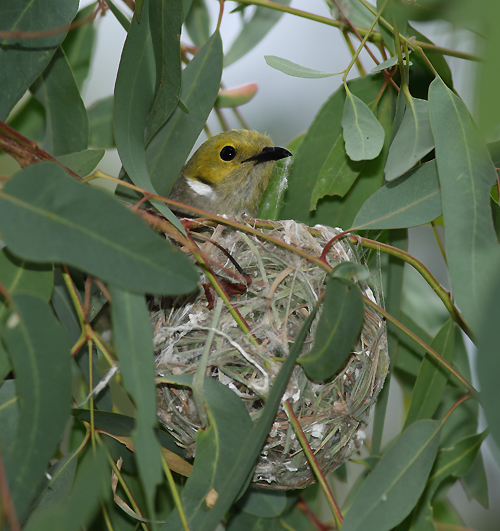
White-plumed honeyeaters are commonly seen in River Red Gum paddock trees. In this photo by Geoff Park, a honeyeater adds cobweb to a delicate cup nest in a eucalypt sapling.
Donations are always welcome, and feel free to bring a plate of nibbles to share.
When: Sunday 9 September from 9:30 am – 2:30 pm
Where: 49 Hayes Rd, Baringhup VIC
This is a free event. We will serve a light lunch of soup and rolls.
What to bring:
*Shoes and clothing appropriate for walking outside in the bush.
*Binoculars if you have them (we’ll also provide some).
RSVP: Bookings and enquiries to Tanya Loos tanya@connectingcountry.org.au or call our office on 5472 1594
Yandoit bird outing – some fine birds
Posted on 13 August, 2018 by Tanya Loos
Landholder John Carruthers recently requested a visit from some experienced birdos to conduct some benchmark bird surveys on his property off Limestone Rd, Yandoit, Victoria. Being a very fine part of the world for birding, this is where we decided to have Connecting Country’s mid-week bird walk.
At 9 am on Wednesday 18 July 2018, our small group met with John at his property. The land is a mix of open country and bush, with Kennedys Gully coursing through open paddocks, and two patches of remnant vegetation with some lovely large old trees. We conducted a 20 minute – 2 ha search, which recorded eight bird species. An area search for the rest of the morning recorded 25 species.
The links to the surveys in Birdata are:
The highlights were a flock of Brown-headed Honeyeaters, a pair of Restless Flycatchers and a pair of Jacky Winters. The Restless Flycatchers and Jacky Winters are birds of open woodlands, so John’s plan to keep some areas open for grazing will be good for these birds.
A lone Yellow-tufted honeyeater was a surprise. Perhaps more of these would be present when the eucalypts are in flower. The Noisy Miners we saw are a concern. Any shrub plantings in the remnants will help discourage these bushland bullies.
While we did not see Brown Treecreepers on the survey, they have been observed at the property previously. The requirements for Brown Treecreepers include lots and lots of fallen timber, so leaving habitat woody debris on the ground will take care of them.
The presence of large old trees on the property, and the extensive native vegetation along Limestone Rd, meant the bird survey recorded a mix of open country and very valuable, threatened Box-Ironbark birds. As a baseline survey, John is starting with the bar set high!
If you already have woodland birds on your property, your restoration plan might include a goal to retain these birds, and provide them with even better habitat by planting shrubs for nesting and food resources.
Thank you, John for showing us your beautiful property, and for your very generous donation to Connecting Country.
Habitat Health Check – our new project!
Posted on 7 August, 2018 by Tanya Loos
In 2009, Connecting Country created a Biodiversity Blueprint with the help of the community and our partners. From the outset, scientific monitoring has been a high priority at Connecting Country. Without monitoring, we don’t know if we’re achieving our goal to restore habitat for native species.
Monitoring achievements
We’ve been fortunate to have a world-class landscape ecologist, Professor Andrew Bennett, assist in creating our monitoring programs for woodland birds and Brush-tailed phascogales. As of 2018 we’ve collected 23,996 individual bird records, and 1,424 records for our phascogale monitoring.
Our wonderful ‘Connecting Landscapes’ project (2013- 2017) worked with local landholders to help restore over 1,600 hectares of land. It also funded staff to establish and run our bird and nest box monitoring programs. These days, funding is more likely to be smaller amounts of money over shorter time scales. In-house monitoring by staff has become a luxury!
In the meantime, we’ve developed a team of highly-skilled and enthusiastic volunteers ready to take a more active role as ‘citizen scientists’. We’re poised to update to a new model that is more community-driven – drawing upon the power of YOU, the community, to contribute data as volunteer citizen scientists.
This change has been in the air for a while. After the success of our ‘Stewards for Woodland Birds’ project, we’re delighted to announce we have funding from the Helen Macpherson Smith Trust to support this important transition.
The new project is ‘Habitat Health Check: empowering citizen scientists to monitor habitat health in Central Victoria.’

Male Hooded Robin. Analysis of our results shows a welcome increase of this species in the Mount Alexander region. Photo by Geoff Park.
Habitat Health Check – analysing and acting on our scientific monitoring
Habitat Health Check is a collaborative, robust, citizen science project that monitors native animals and plants in the Mount Alexander region. We will review our existing, long-term monitoring programs, and move to a new collaborative, targeted model that empowers our enthusiastic and skilled volunteers, improves scientific rigour, and promotes data sharing via the Visualising Victoria’s Biodiversity online portal.
Tanya Loos, Connecting Country’s monitoring and engagement coordinator, will deliver the project between now and 2020. Habitat Health Check will encompass BirdWatch, NestboxWatch, FrogandReptileWatch and PlantWatch.
Some expected highlights
Our scientific data will be analysed by experts from BirdLife Australia and Latrobe University, and the results shared in an exciting evening forum.
Four workshops will review our data and results, and invite the community to explore new scientific questions and methods. How can we best work with the new BirdLife Castlemaine District group? What have we learned in the past eight years? And where to from here?
We’ll collaborate closely with SWIFFT – the State-wide Integrated Flora and Fauna Teams, to share our findings and use this great online resource.
In 2019, we’ll run a competition for the best local photographs of our favourite flora and fauna, for Connecting Country’s very first calendar!
Get ready to get involved
We will be recruiting team leaders to inform and guide our various citizen science programs – so birders, nestbox enthusiasts, plant nuts, reptile watchers and froggers: watch this space!
Small bush bird habitat created at Bradford!
Posted on 30 July, 2018 by Tanya Loos
What a difference a couple of years makes! Last Thursday, 26 July 2018, Bonnie, Frances and Tanya had the great pleasure of visiting Kerri Peacoulakis’ property in Bradford to marvel at the growth of native plant species at their direct seeding site, and also chat about bird surveying. Below is a photo of part of the site taken in September 2016, about one year after direct seeding.
Below is the same site, taken in the same direction. Note the large eucalypt with the wide crown in the left hand side of the photo.
The site was direct seeded in 2015, as part of Connecting Country’s Habitat for Bush Birds project. It is amazing to think that there are many tiny young plants fighting for survival under all the prolific capeweed in the first photo! The site is a bird survey site called NW-PR-03, a northwest paddock revegetation site. The direct seeding is even more successful looking in the other direction, towards the Blue Hills area.
In the above photo, Bonnie is using a trundle wheel and a counter to carry out a direct seeding success count. These counts measure how many plants have grown, giving a standard measure of trees/shrubs per metre count. This number is comparable from site to site, and enables us here at Connecting Country to monitor the growth of our direct seeding from year to year.
The plant species in the direct seeding included a mix of local wattles, eucalypts, she-oaks, hop bush, and hakeas.
Kerri is taking on the bird survey site, by surveying the site four times per year. During our visit, we conducted a 20 minute 2 hectare count, with Kerri entering the data on her Birdata app on her smartphone. So simple! During the survey, we saw many open country species such as Red-rumped parrots, Welcome swallows and Australian magpies. Kerri said that she had observed Superb fairy-wrens on the site – a true mark of success as these little birds are NEVER recorded in a bare, open paddock! Well done Kerri and also her partner Tusker and family for a fantastic project!
BirdLife Castlemaine District launch and Swift Parrot conservation
Posted on 10 July, 2018 by Tanya Loos
Many excited faces gathered at the Castlemaine Botanic Gardens Tearooms on Saturday 7 July 2018, as we celebrated the launch of BirdLife Australia’s newest branch – BirdLife Castlemaine and District. The launch also incorporated an ‘Act for Birds’ Roadshow – a community forum on how we can encourage stronger environmental laws to help safeguard threatened species such as the Swift Parrot.
We began the afternoon with a Welcome to Country from Uncle Rick and Kane, and Uncle Rick talked about the significance of birds to the Dja Dja Wurrung. Fiona Blandford (Branch Network manager) and Jane Rusden (BirdLife District Convenor) formally launched the new branch, with a lovely nod to Connecting Country and our work to build community interest in birds on our region.
Brendan Sydes (Connecting Country president), in his role as lawyer and CEO of Environmental Justice Australia, gave a rousing introduction to the potential for positive change to environmental laws in this country.
Beth Mellick (of Wettenhall Environment Trust) is the regional coordinator for the local Swift Parrot counts done twice a year. Beth gave a wonderful talk on our local swifties and the power of citizen scientists, including showing an excerpt from Debbie Worland’s DVD, the Swift Parrots of Muckleford in Central Victoria. The DVD shows never-seen footage of Swift Parrots filmed entirely in Muckleford over a five-year period by Debbie Worland, a member of the Castlemaine Field Naturalists Club. For infomation about the DVD, email swiftparrotsofmuckleford@hotmail.com. If you would like to be involved in the Swift Parrot count later this year, email Beth at beth@wettenhall.org.au.
We then heard from our main speaker – Kim Garrett (Conservation Community Organiser for BirdLife Australia). Kim spoke passionately and eloquently on how our current laws are failing threatened species in Australia, and what we as community members can do about it. Many policy and environmental law experts have prepared a detailed case for how environmental laws could be strengthened in our country, and the Act for Birds campaign summarises the case succinctly.
In a nutshell, the campaign calls for us to:
- Create national environment laws that genuinely protect our unique birdlife.
- Establish independent institutions that set national environmental standards, and operate transparently and independently of government.
- Guarantee community rights and participation in environmental decision-making.
To get involved, head on over to www.actforbirds.org to sign the petition and get some tips on engaging with your local member.
The Swift Parrot is Critically Endangered and numbers are still declining due to serious loopholes in current environmental laws. The current laws are up for a twenty year review, so now is an ideal time to act.
Please enjoy this gallery of photos of some of the attendees. Many thanks to the staff from BirdLife for travelling to Castlemaine to share in the excitement, to the committee and volunteers of BirdLife District Castlemaine for planning and logistics, Uncle Rick and Kane, the presenters, and to Jane Rusden for pulling the whole event together!
The contact email for the new branch is castlemaine@birdlife.org.au and our new Facebook page is BirdLife-Castlemaine-District
For a great overview of the Swift Parrot and the ‘Act for Birds’ campaign, see this article in the Bendigo Advertisor: renewed-focus-to-save-castlemaines-migratory-parrots/
BirdLife Celebration and Roadshow – 7 July 2018
Posted on 28 June, 2018 by Frances
BirdLife is coming to town, so put 12:30 – 3:00 pm on Saturday 7 July in your diaries folks. Join us at the Tearoom in Castlemaine Botanic Gardens (2 Walker Street, Castlemaine VIC). There will be celebrations, information on how we, the grassroots, can really make a difference, and an art activity for the kids.
BirdLife is bring its ‘Act for Birds’ Roadshow to Castlemaine, with plenty of ideas on how you and I can make a real difference for the natural environment.
The stunning Swift Parrot needs our help to save it from extinction. (Photo by Chris Tzaros)
Drum roll please …… We have a new group in the area: Castlemaine District BirdLife Branch, for all bird enthusiasts and aspiring bird enthusiasts, as well as those who are just curious or like birds a little bit. On offer will be monthly bird outings, some talks and a chance to meet like-minded people, across all age groups. Come along, find out more and meet some of us.
Jane Rusden, Convener Castlemaine District BirdLife Group
Powerful Owl Chat – Thursday 28 June 2018
Posted on 19 June, 2018 by Tanya Loos
Come along and share stories about Powerful Owls at a ‘Powerful Owl Chat’ in Maldon.
Garry Cheers will tell us about Powerful Owl food, habitat, breeding, behaviour and giving owls space during breeding season. Geoff Park will show owl images and talk about what you can do to connect with your local environment.
Bring along your photos and owl knowledge to share. There will be plenty of opportunity to ask questions and share observations. All welcome.
Thursday 28 June 2018 from 7.00 – 8.30 pm
Maldon Neighbourhood Centre (1 Church St, Maldon VIC)
For inquiries please contact Forest Keegel on 0402 035 521 or forestkeegel@gmail.com
Makarrata Garden Tarrangower MaGaTa is happening on Dja Dja Wurrung Country in Maldon. It’s a a community engaged sculpture project to research habitat of Powerful Owl and Duan (Brush Tailed Phascogale), and educate ourselves about the history of Dja Dja Wurrung people and celebrate their living Culture.
Painted Button-quails in the garden
Posted on 29 May, 2018 by Tanya Loos
Connecting Country staff member Bonnie Humphreys has seen small, quail-like birds wandering around her garden for weeks, even on her doorstep. Until now, they’ve escaped Bonnie’s efforts to capture a photo and confirm identification as Painted Button-quail! The two birds seen here were resting quietly together.
Button-quails are a truly Australian group of birds. Although they look a lot like quails, DNA analysis suggests that button-quails are quite distant from all living groups of birds. Their behaviour is certainly very unusual!
Unlike most birds, it’s the brightly coloured female who calls, and attracts a male. They are polyandrous, with one female mating with several males in an area. After mating, the female builds a domed nest near the ground in a shrub or grass tussock, and lays three or four small white eggs. The male then incubates the young until hatching. Once hatched, the tiny little chicks fledge right away and the male feeds them for the next ten days or so. After this, the young button-quails can fend for themselves.
The birds pictured above could be either males, or immature birds. In females, the reddish patch is brighter. However, the depth of the colour red is quite variable according to light conditions and the position of the bird. Hence it’s quite tricky to identify the sex of the bird. (Happy to hear local birder expert opinion on this one!)
Bonnie’s visiting button-quails are a group of three birds, and the Handbook of Australian and New Zealand birds says they are most often seen in small family groups. At this time of year, breeding has finished, so maybe they are just being companionable and foraging together until the female starts her ‘booming’call.
Their foraging technique is also most unusual. Painted button-quails often feed in pairs, in grasses and leaf litter on the ground. They scratch and glean, spinning on alternate legs to create distinctive circular depressions, known as platelets. Platelets are often the only visible sign that the bird is present. The photo below shows the typical look of platelets in bushland with plenty of leaf litter.
There’s been extensive feeding activity in leaf litter and lawn areas at Bonnie’s place. It was hard to capture on camera the sheer extent of the ground being worked over by these enthusiastic little birds.
Painted button-quails are a member of the threatened Victorian Temperate Woodland bird Community. They are notoriously difficult to capture during typical (20 minute, 2 ha) bird surveys, so we welcome any sightings and observations. You can download a sightings sheet here, and let us know where and when you’ve seen button-quails, or their platelets.![]()
In 2011, Echidna Walkabout Tours captured this amazing footage of a Painted Button-quail foraging in leaf litter in urban Port Melbourne! Do watch the whole video because at the end the female puffs herself up like a frog and starts calling her booming call. The low frequency call is difficult to hear on the video, but you can see the amazing behaviour!
Eastern Yellow Robin Talk – Thursday 31 May 2018
Posted on 16 May, 2018 by Tanya Loos
All are welcome to join Lana Austin of Monash University in Newstead next week as she unpacks the bizarre genetic story of what is known (and not known) about the Eastern Yellow Robin. Lana will also explain how volunteers can participate in this fascinating genetic study.
When: Thursday 31 May, 2018 at 7 pm
Where: Newstead Community Centre: the Mechanics Hall (Lyons St, Newstead VIC)
This is a free event, with no need to book!
We featured the Eastern Yellow Robin project on the blog last week – read the story here if you missed it. And click here for a poster about the event.
Caught on camera!
Posted on 10 May, 2018 by Tanya Loos
This remarkable photograph shows a Yellow-footed Antechinus bounding up a log with an Australian Magpie in hot pursuit. It was taken by a trail camera – amazing timing!
In this case, the antechinus escaped being breakfast, running so fast all of its paws are in the air! It is great to see the tables turned on these adorable but voracious hunters (see pictures of a Yellow-footed Antechinus preying upon a grey fantail here).
The landholders who sent us the photo said ‘These wildlife cameras are great! We catch so much and are able to watch so many different animals, birds, reptiles, insects, etc. and what they get up to each day.’ Lynne and Ric live on a beautiful woodland property east of Maldon, and are keen bird surveyors.
If you would like to see what lives on your property, why not borrow a wildlife camera from us? We are happy to loan wildlife cameras to our members – usually for a three week period. To book one, email tanya@connectingcountry.org.au or phone us at the office on 5472 1594.
Many thanks to Lynne and Ric for the amazing photo.
Swift Parrot surveys on 19 and 20 May 2018
Posted on 10 May, 2018 by Tanya Loos
Swift Parrot survey season is upon us again, with a monitoring weekend coming up on 19 and 20 May. BirdLife Australia’s Swift Parrot monitoring program is essential for assessing where our beloved swifties are, what resources they are feeding upon, and their numbers.
Our regional coordinator for swift parrot surveys is Beth Mellick from Wettenhall Environment Trust. If you would like to be involved in this Autumn’s swift parrot count, contact Beth via email to be assigned a site (email: beth@wettenhall.org.au). And regular watchers – don’t forget to let Beth know where you are surveying so we can make sure we cover our whole region!
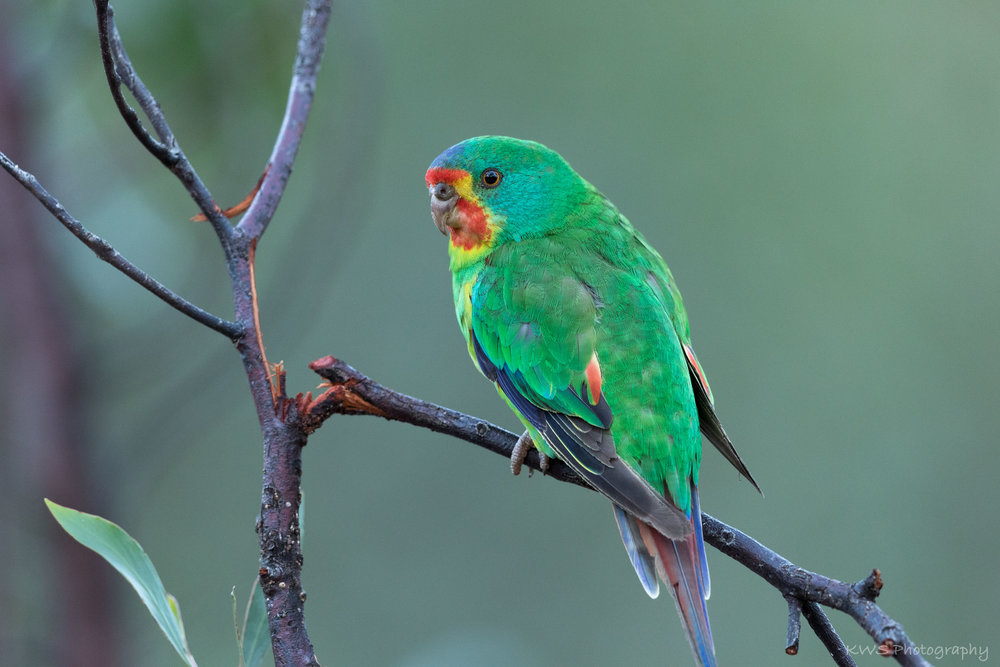
This beautiful Swift Parrot was photographed by Connecting Country member Micheal Gooch, visiting his bird bath in Clunes (www.outsidefourwalls.com)
Chris Timewell (formerly of Connecting Country and now with BirdLife Australia) provided this update on Swift Parrot (and Regent Honeyeater) surveys:
We are again seeking volunteers to search for both species across Victoria, NSW, ACT and Queensland, as Swift Parrots make their way up to the mainland from Tasmania and Regent Honeyeaters move about the landscape in search of flowering Eucalypt trees to feed on. The May 2018 Swift Parrot and Regent Honeyeater survey weekend is coming up soon on May 19th and 20th. As always, we are happy for people to undertake their searches up to a week on either side of the survey weekend. Opportunistic sightings from any time of the year are also welcomed.
So far this season there have been scattered Swift Parrot sightings from across its mainland range – with the highest clusters around the north-eastern fringes of metropolitan Melbourne and returning birds to favourite haunts such as Mt Majura (ACT) and the Cessnock forests of the Lower Hunter (NSW). There are Spotted Gums noted flowering on the South Coast of NSW (e.g., Marramarra National Park), Coastal Grey Box is flowering in the Lower Hunter and Swamp Mahogany is starting to flower in coastal areas – each of which are attracting large number of lorikeets and other nectar-feeders.
If you are new to the plight of this Critically Endangered parrot, the BirdLife website has a profile on swift parrots here.








